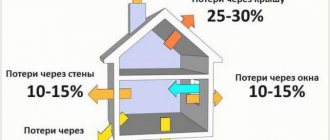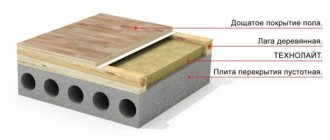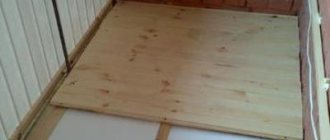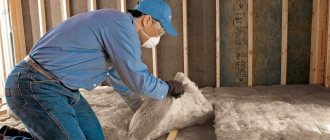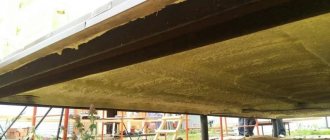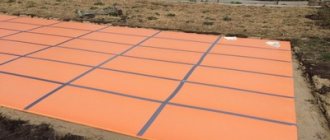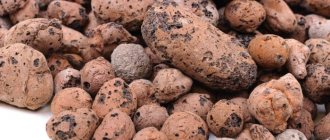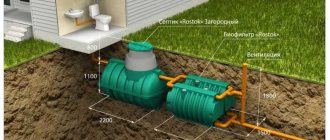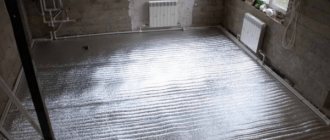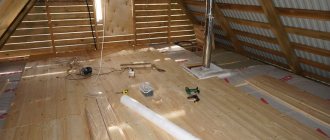Thermal insulation of floors in country houses, garages and any other one-story buildings is considered necessary. Indeed, according to various estimates, up to 20% of the heat accumulated in the house leaks through the floor. Insulating a floor is easier than insulating walls or ceilings. Especially if you use a material such as polystyrene foam, which has many advantages compared to other floor insulation materials. In addition, floor insulation with polystyrene foam can be done independently, without the involvement of skilled specialists.
The ratio of heat loss in the house
What is foam plastic
The name itself suggests the answer - it is a foamed plastic mass (polymer). It is created by the formation of granules filled with air and interlocked with each other. This technology creates a material that is more than 90% filled with air. This ensures its low thermal conductivity and unusually low weight. The starting materials for the production of this material can be various polymers. But traditionally polystyrene foam is called foamed polystyrene.
There are two ways to create expanded polystyrene.
- Conventional polystyrene foam is formed when the raw material mass is exposed to steam in a molding container. This is a well-known easily crumbling tile material, usually white.
Traditional expanded polystyrene foam
- Extruded polystyrene foam is made from pre-melted raw materials by pressing (extrusion) in special molding units. The resulting material has a denser structure, which provides greater strength and flexibility compared to conventional foam. But at the same time its weight increases.
Extruded polystyrene foam boards
Main article: floor insulation with sawdust.
What to use polystyrene foam or penoplex
Quite a frequently asked question, to which many “masters” cannot give a detailed and constructive answer.
It is generally accepted that polystyrene foam and penoplex are almost identical types of insulation, but this is far from true. These materials are largely similar in their performance qualities, but penoplex is a more modern and safer heat insulator.
If funds are available, penoplex is the more preferable type of insulation
If we consider it in the context of our topic, then both materials can be used to insulate the floor of a private house.
The only difference is that for floors on the ground floor, under which there is a cold basement or street, it is better to use penoplex. For thermal insulation of the floor of the second floor or attic, it is more advisable to choose polystyrene foam.
If funds are limited, then thicker foam sheets may be used for thermal insulation of the first floors.
Material on the topic: Thermal insulation of a concrete floor with polystyrene foam.
The thickness of the foam for floor insulation must be at least 10 cm with a density of 25 kg/m3. This density corresponds to insulation marked PSB-S-25.
Properties and characteristics of polystyrene foam as insulation
Thermal insulation of any buildings and structures requires a material with a low thermal conductivity. The weight of the insulation also matters. The table provides comparative data on these characteristics for foam plastic and other building materials.
| Material | Thermal conductivity, W/m*°С | Density, kg/m3 |
| Foam plastic of different brands | 0,038 – 0,043 | 15 — 50 |
| Extruded foam | 0,03 – 0,032 | 33 — 45 |
| Tree | 0,18 | 500 |
| Brick | 0,55 – 0,85 | 1500 |
| Expanded clay concrete | 0,58 | 1200 |
| Drywall | 0,21 | 800 |
| Mineral wool boards | 0,07 – 0,08 | 125 — 200 |
As you can see, the wood from which country houses are built is 4 to 5 times inferior to foam plastic in terms of insulation. And in terms of lightness, foam plastic surpasses almost all other heat-insulating materials.
But, before you get acquainted with how to insulate any floor with polystyrene foam, it is worth listing all its advantages and disadvantages.
Advantages of polystyrene foam
The positive qualities of this insulation are not limited to one or two properties. An extended list of its advantages is as follows:
- Low thermal conductivity allows the insulation to be laid in a relatively thin layer. This is critical for insulating some floors in low rooms.
- Light weight does not create a load on the surface.
- Waterproof. Does not allow moisture to pass through and retains its shape in a humid environment.
- Foam plastic retains its qualities in the temperature range from minus 50 to plus 95 ° C.
- Easy to process - can be cut with a regular knife. This is combined with ease of installation - you can easily cut slabs from it to any size.
- Does not require specialized installation skills. Anyone can lay an insulating layer of polystyrene foam with their own hands. This does not require any additional equipment or special clothing.
- Low price. For many this is the deciding factor.
- The material is “unattractive” to rodents and insects.
Disadvantages of polystyrene foam
- The main disadvantage is low fire safety. Expanded polystyrene not only burns in an open fire, but when burned it releases harmful substances that can cause suffocation. It is for this reason that it is recommended, whenever possible, to carry out thermal insulation with foam plastic on the outside of the insulated room.
- Poor vapor permeability. Because of this, moisture can settle on its surface, which can lead to mold or mildew.
- Weak mechanical strength. Ordinary polystyrene foam breaks when bent and crumbles when impacted. The extruded version is more stable in this regard.
Technology
The work process begins with the preparation of the rough coating. To do this, the concrete base of the floor is leveled using cement mortar. After this, the base is cleared of construction debris and dust. Then you need to fill the initial screed. This is necessary for the final leveling of the floor base. The recommended thickness of such a screed varies from 3 to 5 centimeters. We recommend using the minimum thickness. Do not forget that waterproofing, insulation and the main screed will be installed. To this you can add the thickness of the finishing coating. Floors that are too thick will reduce the height of the rooms in the apartment.
USEFUL INFORMATION: How to level concrete and wood floors under laminate
After the preliminary screed has set, you can begin laying the waterproofing layer. Usually special waterproof films are used under foam plastic. They are laid overlapping, all seams are taped with special tape. Remember that the waterproofing layer should extend approximately 10 centimeters onto the walls of the room.
It is not recommended to use mastic or bitumen under foam plastic as waterproofing. A conflict of materials will arise and, as a result, the foam will begin to melt. If you still decide to use bitumen, then a plastic film should be laid between the layers of waterproofing and insulation.
Sheets of foam plastic are laid on the moisture-proof layer. Remember that the higher the apartment is, the thinner the foam can be used under the screed.
The sheets are coated with glue and laid on waterproofing. This is done in such a way that the seams of adjacent sheets are not on the same straight line. After all the sheets have been laid, there should be a small gap between the wall and the insulation. This is a precautionary measure in case the building shrinks. Gaps are sealed using damper tape. The gaps between the foam sheets are covered with adhesive.
To adhere the insulation to the finishing layer of the screed, it is necessary to perform reinforcement. To do this, pour a thin layer of cement-sand mortar. Recommended thickness is 1-1.5 centimeters. A metal reinforcing mesh is installed in the poured solution.
It is worth noting that screed on polystyrene foam can be done without reinforcement. This material has a denser structure, so it is quite capable of providing reliable adhesion.
Then the main screed is poured. For this, a concrete mixture is usually used. The thickness of the coating must be at least 5 centimeters. To fill the screed evenly and without much difficulty, it is recommended to use special beacons. The role of beacons is played by a metal profile, which is laid on a reinforced layer and leveled. The screed is poured between the beacons and leveled with a special strip or rule. Final smoothing is done using a spatula.
USEFUL INFORMATION: Repairing the floor in an apartment with your own hands step by step
When leveling the screed with a spatula, do not forget to periodically pierce the surface with a thin metal rod. This is necessary to remove air from the solution structure. This nuance will have a positive effect on the strength of the floor.
The screed must dry for at least 28 days. This is exactly how long it takes for concrete to gain maximum strength. If work is carried out in the summer, it is recommended to periodically spray the concrete with water. After this, you can begin finishing the floor.
Is polystyrene foam harmful to health?
This question still does not have a precise answer. On the one hand, one can come across claims that polystyrene foam releases many harmful substances that adversely affect numerous aspects of human health. On the other hand, over decades of using polystyrene foam in various fields, no cases of diseases associated specifically with the use of this material have been identified. And its use still continues even in the food industry.
It is reliably known that under the influence of sunlight or high temperature, an element harmful to health, styrene, is released from polystyrene foam. But under normal conditions, if styrene is released, its amount in the air does not exceed the maximum concentration regulated by sanitary standards.
However, for safety reasons, it is worth paying attention to the styrene content in the purchased polystyrene foam. In the best samples of imported materials, this value of harmfulness of the material does not exceed 0.05%. Unfortunately, in low-quality varieties of expanded polystyrene the styrene content reaches 0.2%.
If you want to use polystyrene foam, but health concerns are a concern, then be sure to insulate the floor with polystyrene foam only from the outside, and not from the inside of the living space.
Tools for processing polystyrene foam
Although it is obvious that polystyrene foam is an easy-to-process material, you can find references to special thermal cutters or even machines for cutting this material. But they are rather required for those who constantly work with this material or are engaged in figure cutting. For a one-time use, it is hardly advisable to purchase an expensive device, and shaped cutting for an insulated floor is not required.
When cutting foam plastic for floor insulation, the following tools may be required:
- An ordinary knife. A sharp knife with a long blade is capable of cutting any type of polystyrene foam. Even a kitchen knife with a serrated edge will work for thin slabs.
- Hacksaw. Some may find it more convenient to cut the material with a hacksaw. Please note that a hacksaw with fine teeth is better suited for cutting foam. A larger tooth will produce a more chipped edge.
- String. For this purpose, you can use old guitar strings attached to two handles. They cut with such a device as a two-handed saw.
Of course, these tools are not able to provide a smooth edge at the cut points. But for joining foam plastic floor slabs, a perfectly straight edge is not needed.
Helpful advice. When cutting foam with any of these tools, it is recommended to provide a liquid lubricant on the cutting surface. This will make it easier to work with the tool and reduce the unpleasant sound that accompanies cutting.
Features of foam insulation of various floors
Strictly speaking, “insulation” is not quite the correct term. Polystyrene foam, like any other material, does not provide any insulation, but simply provides high-quality thermal insulation. But it just so happens that when talking about thermal insulation, the word “insulation” is used with the same meaning.
Floors to be laid differ both in the material of manufacture (wood, concrete) and in the conditions of their location and operation. Each of these types of floors has its own characteristics of thermal insulation and recommendations for its installation. Understanding how to properly create foam insulation for a specific type of floor will help you avoid mistakes.
The main problem for the foam plastic insulation layer is the violation of thermal insulation at the joints of the sheets. Often, to securely join two sheets of foam, chamfers are removed along the edges. But now on sale there are sheets of expanded polystyrene with ready-made chamfers along the edges.
Expanded polystyrene sheets with chamfers
But foam plastic sheets are also produced that are joined to each other using the “tongue and groove” principle. This technology provides a virtually indestructible insulating layer.
Plates joined using tongue and groove technology
Floor with an unheated basement underneath
If it is possible to install thermal insulation on the basement side, then you should definitely take advantage of it. Of course, insulating the floor from the bottom of the ceiling is difficult and tedious, not to mention the fact that work in the basement is often carried out in cramped conditions and darkness. But insulation from the side of the cold source, which is the basement, is considered correct according to the laws of heating engineering. And such thermal insulation works effectively and for a long time.
The technology for laying insulation is simple: the basement ceiling is covered with sheets of foam plastic. Methods for attaching sheets to the ceiling:
- On glue. You can use regular glue, for example PVA. But it is better to purchase specialized glue for polystyrene foam. Do not use adhesives containing acetone. They will corrode this insulation.
- Fastening with special “umbrella” dowels with a wide head.
Dowel “umbrella” for additional reinforcement of foam
- Combined fastener. Sheets of foam plastic are glued to the ceiling, and then nailed with several dowels for greater reliability.
Insulation of the floor from below - basement ceiling covered with sheets of foam plastic
Thermal insulation of the floor along the joists
This is the simplest and most cost-effective method of foam thermal insulation. Its advantage is that the load of the finished floor falls on the logs. Therefore, the strength characteristics of the foam layer do not matter.
- A waterproofing film is spread on the prepared and cleared of debris base.
- Wooden logs are laid
- Foam sheets are laid between the joists
- The joints between the sheets and in places adjacent to the joists can be filled with polyurethane foam.
- A vapor barrier layer is laid on top of the insulation.
- The finished floor is installed along the joists
Floor insulation with foam plastic under concrete screed
This design, in which the insulation is located under a layer of concrete, is sometimes called a warm screed.
Warm screed installation diagram
In this case, the foam layer bears the entire load of the floor, so measures must be taken to reduce it. Significant level changes will lead to destruction of the foam sheet.
- The preparation of the base must be carried out carefully. All irregularities (pits, crevices and cracks) that could lead to damage to the insulating layer are sealed.
- A layer of waterproofing is laid. The waterproofing film is laid overlapping with an overlap of 5 - 10 cm and overlapping the walls at the same distance. The joints are insulated with tape.
- The next stage is laying foam boards. To securely fix them, it is useful to apply glue or foam along the edges of each plate.
- If the insulation sheets do not have chamfers or grooves with tenons, then the joints are filled with polyurethane foam.
- A polyethylene film is spread over the laid insulation. Its task is to prevent the penetration of moisture when pouring a concrete screed.
- To evenly distribute the load on the foam, laying a metal grid is required.
View of an insulated floor before pouring a concrete screed
- At the final stage, the concrete screed itself is poured.
Pouring a warm screed with concrete mortar
Is it possible to insulate wooden floors with polystyrene foam?
Some experts do not recommend thermal insulation with foam plastic laid on a wooden base. For wooden load-bearing structures, reliable ventilation is important to prevent the formation of dampness. Polystyrene foam is an airtight material, and when laying it on a wooden base, it is possible that there will be a complete lack of air flow to the tree. This is fraught with the fact that sooner or later moisture will accumulate under the foam layer, which will destroy the wooden elements of the floor.
But the wooden floor, which is supposed to be laid on the ground, can be insulated with foam plastic.
Ground insulation scheme
The installation process is as follows:
- The soil is firmly compacted
- A cushion of sand and crushed stone is laid on the ground
- A layer of waterproofing is spread
- Expanded polystyrene sheets are laid. For soil laying, it is advisable to choose a material of increased density - at least 35 kg/m3. For lower-density foam, it is worth laying it in two layers, with the seams moving between the sheets.
- Before laying the finished floor, the entire insulating layer is covered with a vapor barrier film.
How to insulate a screed with foam plastic?
Scheme of insulating the screed with foam plastic.
For these activities, if you do the work yourself, it is best to use a material with a density value of 35. And for better joining, choose sheets that have milled edges.
This option is suitable not only for owners of a private house, but also for those who live on the first floors of an apartment building.
- Polyethylene should be spread underneath the foam. This layer will help create insulation.
- The sheets are laid over the entire surface of the room; the joints are best filled with polyurethane foam or properly secured. A mesh is installed on top of the foam. Next they make a screed. It can be made of various materials, most often it consists of concrete.
- After the screed has dried, you can begin laying the floor coverings.
As for the thickness of the foam, the height of the ceilings should be taken into account. Due to the insulation and screed, several centimeters are lost, so a layer that is too thick is not recommended. For an ordinary apartment, a thickness of 20-30 mm will be sufficient.
